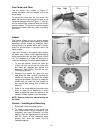
14
To remove headstock, tailstock or toolrest base
from the bed, unscrew and remove either of the
stop bolts (B, Figure 14). After re-mounting
these items on the Lathe, re-insert the stop bolt.
For most turning operations, except outboard
turning, the headstock should be positioned at
the left end of the bed, and only the tailstock
moved to accomodate the workpiece.
Cam Tightness
If the headstock, tailstock or tool rest base does
not tighten properly down against the Lathe bed
when the locking handle is tightened, it may
need adjusting. Figure 15 uses the tailstock as
the example:
1. Unscrew and remove the stop bolt on the
end of the lathe bed (B, Figure 14) and slide
the tailstock off the end of the bed.
2. Turn the tailstock on its side, and tighten the
lock nut with a wrench. See Figure 15.
3. Mount tailstock on bed and insert the stop
bolt.
Tool Support
A 14” tool support is provided with your Lathe. It
is designed to allow adjustment for height,
position on the bed, and angle to the work.
Loosen the locking handle on the tool support
base (C, Figure 16) to slide the support base
forward or back, and to angle it to the bed.
Tighten the locking handle firmly before
operating the Lathe.
Loosen the small handle (D, Figure 16) to raise
or lower the tool support and angle it to the
work. Tighten the handle before operating the
Lathe.
The small handle (D, Figure 16) can be inserted
into one of three holes on the tool support base.
The position shown in Figure 16 is preferred so
that the locking handle contacts the groove in
the tool rest shaft.
Locking Handles
Each small locking handle such as D, Figure 16
can be rotated to a more convenient position.
Simply lift up on the handle, rotate it on the pin,
then release it, making sure it seats itself on the
pin.
Figure 15
Figure 16


















